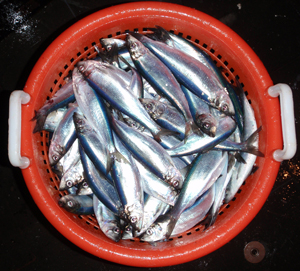New rules in the herring fishery aimed at improving sustainability for the important lobster bait fish are impacting fishermen, dealers and others.
The fishery, mostly centered in Massachusetts and Maine, grew in the 1960s but has been in decline since the 1980s. In 2018, 43,878 metric tons were landed. But by 2019, 12,998 mt (valued at $9.72 million) was landed. 2020 landings were 9,368.5 mt (valued at $6.77 million), according to NOAA economist Min-Yang Lee.
The 2021 fishing season started Jan. 1, with an annual catch limit of 11,571 mt, divided among four herring management areas. However, once Framework 8 to the herring management plan is implemented, the total ACL will be set to 4,128 mt. The 2020 stock assessment shows spawning stock biomass to be at its lowest value since the late 1980s.
Wayne Reichle, president of Lund’s Fisheries in Cape May N.J., calls the quota reductions “a disaster for the region’s herring fishery.” Reichle says fleet has stayed within quota the last few years, so the low biomass and poor recruitment is “attributable to the stress of a cold-water fish being challenged by a warming ocean.” Many say it is too early to predict to what extent herring supplies will impact prices, given the newest reductions. In mid-March, herring prices in Maine were about $250 per barrel at the docks.
Brittany Willis, general manager of JBR Maine, a wholesale bait and lobster company with four locations in Maine, says this year may not look much different than last.
“Demand is always high, but the supply just isn’t here,” Willis says. “Last season, I think we expected the herring price to skyrocket more than it did. But because pogies were so abundant, the prices for herring weren’t as high as expected.”
While fisherman and dealers will contend with new limits, vessels that target herring could have limited opportunities to engage in other fisheries.
“We are a dealer and small boat owner,” says Stacey Myers, an employee at Harbor Bait in Boothbay Harbor Maine. “The areas that we usually fish in have had quota cut by another 60 percent (or so) this year. It’s not going to profit us. We won’t even send the boat out. If we do, we might only get a couple of trucks.”
Finding crews could also prove difficult, adds Myers. “The fishing isn’t going to pay what it used to, or people will go work with bigger boats.”
Another impact of the reductions is that international markets will turn to herring from other countries with healthy stocks. Meanwhile, adds Reichle, “domestic markets will meet demand using other domestic species or importing herring from other origins.” This year, a lot of bait dealers have turned to other states or Canada to fill herring supply gaps. “And the menhaden fishery has definitely helped fill that gap,” says Willis.
But this year, the menhaden (pogy) fishery will face its own limits.
“Pogies have been supplemental for us,” says Myers, “but the state has made it so that it’s limited, too. So what some lobstermen are doing is going out and catching the limit (17 barrels) and then selling them, so that’s hurting our business as well.”
Myers and other dealers say that by fall, when pogies and herring are both gone, the lobstermen tend to need more of what’s been stored by dealers. “Last year,” says Myers, “our strongest sales were in the fall, and price was steady.”
Over the years, bait dealers have grown accustomed to sourcing alternatives to herring.
“We’re really focused on trying to find those new species,” says Willis, “to fill the gap with all the restrictions on herring and pogies.” Interestingly, adds Willis, her company JBR Maine may be the only bait dealer in Maine offering catfish head bait, sourced from Alabama.
“Pricing is comparable. Right now herring is $240 a barrel while it’s $220 a barrel for catfish heads,” she said. While Willis does not consider catfish to be a replacement for herring, “it certainly helps earlier in the season — and we can save herring for lobster shedder season.”
Over at Harbor Bait, the expanded bait menu now includes pork and beef, says Myers.
“The pork is called backfat, and its popular — we’ve been selling a lot. The price is usually a $1 per pound — we get it from Maine, along with the beef.” Not every herring alternative works, of course, adds Myers: “We’ve tried tuna heads, but they’re not that popular because they are too big!”
From catch limits to biomass to regulations, it can be difficult to find optimism in the herring industry.
“Vessels fishing historically for herring will have a difficult time surviving if those boats do not have alternative permits attached to them,” adds Reichle of Lund’s. “At the same time, there are reports of large biomasses of small herring on Georges Bank. This is proof that a new year class is building and, hopefully, we will see the fishery bounce back in the next three to four years, as it did after a prolonged period of poor recruitment during the late 1970s and early 1980s.”







